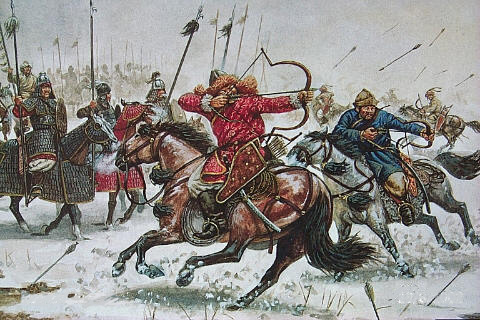
Originally the basis of the Mongols’ military power and later almost driven to extinction by the advent of firearms, archery has been revived in Mongolia as a purely recreational sport.
Mongolian archery in the Middle Ages had great military significance. The earliest surviving piece of Mongolian writing is a stone inscription set up in 1226, which records a 335-fathom (about 575 yards) bow shot made by CHINGGIS KHAN’s nephew Yisüngge. The Franciscan friar JOHN OF PLANO CARPINI observed that Mongols began shooting from their second year and that from child to adult they were all excellent marksmen. Mongolian men spent most of their time making their own arrows, which had a number of different heads made with bone or iron.
Under the QING DYNASTY (1636–1912) training in archery was required of all bannermen. The military compound bow used was only about 1 1/4 meters (four feet) long, although ones more than two meters (six feet) long were also used for hunting. Bows were composed of a goat horn or deer antler core covered by wood (larch, elm, or bamboo) and wrapped in animal tendons. The bow’s powerful tension made it spring back when unstrung, and Mongolian EPICS frequently cite the difficult task of stringing a powerful bow as the distinguishing test of the hero. The bowstrings were made of silk threads or leather wrapped in tendons, the arrows of pine, birch, or willow fletched with feathers of a lammergeier, eagle, or falcon, and fitted with heads of deer antler, bone, or iron. Well-constructed compound bows and arrows were highly prized and fetched high prices. Hunters used this powerful war bow for large game, but small game was also taken with a simpler bow made of strips of fir or larch cut from the stems and wrapped with tendon. The bowstring was a length of hide, preferably horsehide.
Mongolian traditional bow technique involved putting the arrow on the right, or outer, side of the bow. The arrow was held with the thumb and forefinger and the bowstring drawn with the thumb, which was protected by heavy leather or a polished stone ring. The string was released by rolling it off the ring. Under the Qing the ability to handle a pull weight of about 37 kilograms (80 pounds) was considered the minimum for a grown man, and one of about 60 kilograms (133 pounds) was necessary for men who wished to participate in the imperial hunt. Training encompassed not only shooting from a standing position but also shooting while galloping on horseback, when the reins were taken up in the left hand or mouth while the right hand pulled back the bow. The targets for these military competitions were made of sheepskin stretched over wooden frames or wooden balls placed on poles about 1.7 meters (5.5 feet) high. Since the Mongols found it disturbing for target shooters to target a person or animal, even in their imagination, the target was sometimes called a mangas, or monster.
In the NAADAM “games” that accompanied religious rituals, archery was practiced with large, blunt ivory heads. The most common target was a pyramid or line of sur, made of leather straps rolled into a cylinder and filled with oak bark or leather, which was to be knocked over. At the beginning of the competition, the umpires (uukhaichin, or “uukhai sayers”) gave a cry of uukhai, accompanied by a circular motion of their arms with the hands pointed up to the sky to summon good fortune. The same cry accompanied each striking of the target and the final tallying of the score. The victorious archer received the title mergen (sharpshooter, but also wise man).
By the late 19th century, however, firearms were clearly more useful in hunting and warfare, and the archery competitions became desultory. Among the lamas of Khüriye (modern ULAANBAATAR), who were forbidden by the letter of the vinaya (monastic discipline) from even being in the presence of weapons of war, shooting astragali (shagai) became a widespread sport. In it lamas shot lined-up astragali (shagai) at a distance of 3 meters (9 feet) with horn or ivory bullets flicked by the middle finger from a wooden plank.
In 1922 the army Naadam in Mongolia (later the National Holiday Nadaam) and in 1924 the Sur-Kharbaan (Archery) games in the BURIAT REPUBLIC became annual events, beginning the revival of archery as a sport. In the National Holiday Naadam rules, each man fires 40 arrows at a distance of 75 meters (246 feet). In the 1960s women began to compete in the event, shooting 20 arrows at a distance of 60 meters (197 feet). This innovation had been adopted first among the BURIATS and in the 1950s in Inner Mongolia. While traditional bows are still used in Mongolia with the traditional fingering, Buriat and Inner Mongolian archers use European- style professional model bows and have adopted the Western shooting style.